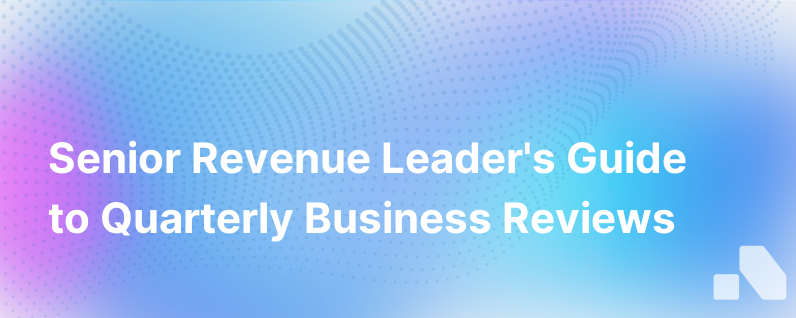
A Quarterly Business Review (QBR) is an instrumental checkpoint for strategic alignment between senior revenue operations leaders (RevOps) and the broader company's go-to-market approach. As a senior RevOps leader, running an effective QBR isn’t merely about past performance reporting – it’s a forward-looking, strategic dialogue that propels sales efficiency, collaboration, and revenue growth.
In the heart of this crucial meeting lies a well-defined process emphasizing reflective learning, cross-functional coordination, and action planning. Below, I share an in-depth guide on how a senior RevOps leader can expertly craft and conduct a QBR that not only brings value to the team but also reinforces the operations framework critical for scalable growth.
Preparation For The QBR
Set Clear Objectives
Identifying clear objectives drives the focus for your QBR. You might examine topics such as sales performance, pipeline health, operational efficiency, customer retention, or market expansion strategies. Primitive objectives could include:
- Reviewing and learning from sales performance data
- Aligning on goals and targets for the following quarter
- Unifying cross-functional teams around a common strategy
Gather and Analyze Data
Data is the linchpin of any QBR; hence, gathering comprehensive insights is essential. Analyze sales performance, funnel conversion rates, customer acquisition costs, lifetime value, churn rates, sales cycle lengths, and more. Use previous quarter data as a foundation and draw trends, anomalies, and forecasts from it. Tools like CRM systems and business intelligence platforms are invaluable here for compiling and visualizing data.
Create a Comprehensive Agenda
Itemize each element of the discussion. The agenda might segue venturesome areas such as retrospective analysis for different sales teams, market trends, customer success stories, and strategic initiatives. Detailing each segment with time allotments ensures that the meeting stays on track.
Involve Cross-Functional Teams
Gather input and insights from marketing, sales, customer success, and product teams before the meeting. This collaborative stance ensures that you're not only spotlighting sales data but are also bringing a cross-functional lens to the QBR, assuring richer conversations and unequivocal alignment.
Running the QBR
Start with a Performance Recap
Begin your presentation with a high-level recap of the previous quarter's achievements against set objectives. Identifying both wins and misses sets a transparent atmosphere and invites productive dialogue. This is where you highlight key performance indicators (KPIs) such as achievement of revenue targets, progress on strategic initiatives, and operational milestones reached.
Deep Dive into Data Analysis
Following the recap, delve into a deeper data analysis. This is where you get granular with the performance metrics, dissect pipeline health, and review forecast accuracy. Dissect sales cycles, win rates, and deal sizes by various segments such as product lines or customer segments. Accurate and in-depth analysis here is fundamental for uncovering bottlenecks and areas ripe for optimization.
Strategic Discussion and Problem-Solving
This portion of the QBR should unfold as an engaging strategy session. Lead a solution-oriented debate on under-performing areas, exploring the root causes behind them. Critically examining both internal processes and external market changes engenders a comprehensive understanding of influencing factors on revenue outcomes.
Goal Setting for the Next Quarter
Harness the insights from the review and discussion to re-calibrate targets and set goals for the next quarter. These should encompass sales targets, efficiency improvements, customer satisfaction levels, new market entries, and product launches. The clarity of these objectives directly impacts the success of your go-to-market strategy – they must be specific, measurable, achievable, relevant, and time-bound (SMART).
Cross-Functional Team Alignment
Each department's activities can significantly affect the others, and alignment is key to seamless execution. Use the QBR as a platform to reiterate the interdependencies and foster a sense of shared purpose. This could mean aligning on key initiatives, campaigns, customer success strategies, and product development timelines.
Accountability Measures
Establish clear ownership for each deliverable. Define who is responsible for what, and set check-in points. This ensures that post-QBR, there is no ambiguity surrounding execution responsibilities, and the roadmap ahead is transparent.
Open Forum for Feedback
Invite comments, questions, and suggestions from the attendees. An open dialogue helps in unearthing fresh perspectives and also garners collective buy-in for the outlined strategies and objectives.
Recap and Conclusion
Finally, provide a comprehensive summary of the decisions made, goals set, and action items identified. Affirm next steps and distribute a clear outline of the QBR’s outcomes to all stakeholders.
Post-QBR Follow-up
Distribute the Meeting Minutes
Sharing QBR minutes and action plans solidifies the commitments made. The minutes should also be stored as a reference point for the next QBR, ensuring accountability and continuity.
Implement and Track Progress
As a leader, your role is now to oversee the implementation of the QBR action items. Regularly tracking progress against the outlined objectives will be essential for maintaining momentum and making any necessary mid-quarter adjustments.
Continuous Communication
Keep communication channels open. Encourage ongoing dialogue and check-ins to keep everyone aligned and adjust strategies as needed.
Feedback Loop
Create mechanisms to continuously gather feedback from the team. This feedback loop helps to refine the QBR process itself and enhance the coordination between departments.
Conclusion
The true power of a QBR lies in its thoughtfully structured approach to retrospective analysis, strategy alignment, and proactive planning. As a Senior RevOps Leader, your role in running these sessions is pivotal to driving the company's revenue growth and aligning the team around common goals. Crafting an effective QBR is not just about running a meeting; it's about reinforcing a culture of continuous improvement, cross-functional synergy, and relentless execution.